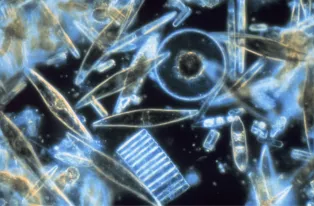Silicon has a crucial effect on the planet’s climate
A comprehensive research project on the mineral silicon and the anonymous climate heroes in the oceans, diatoms, is now starting. Every day, the tiny diatoms, which are a type of phytoplankton, absorb enormous amounts of carbon from the atmosphere. And when they die, they take the carbon with them.
Daniel Conley, a professor of biogeochemistry at Lund University in Sweden, has been awarded nearly EUR 3.3 million for a five-year project on the global silicon cycle. The funding comes from the Knut and Alice Wallenberg Foundation. The project is to be implemented in collaboration with researchers from Linnaeus University, also in Sweden. The researchers will investigate changes in the cycle of the silicon mineral over millions of years.
"The cycling of silicon is of crucial significance to our planet’s climate and for biological productivity", says Daniel Conley.
When silicon in the bedrock breaks down, the decomposition process uses carbon dioxide, which reduces the amount pf carbon dioxide in the atmosphere. In seawater, silicon is crucial for how many diatoms can survive, as these phytoplankton need large amounts of silicon for their hard, porous cell walls, called frustules. Diatoms may seem tiny and inconspicuous, but they absorb around 53 million tons of carbon every day, in the form of carbon dioxide, through photosynthesis. This figure can be compared with human use of fossil fuels, which releases around 21 million tons of carbon per day. When the diatoms die and sink to the sea bed, they play an important role in taking carbon dioxide with them from the surface water down into the depths of the ocean.
In the new project, Daniel Conley and his colleagues will investigate how the diatoms and other phytoplankton may have contributed to regulating silicon levels in the oceans over the past billion years. The researchers have identified three periods of time which are highly likely to have been marked by tangible but largely unexplored changes in the cycle of silicon in the oceans. The oldest period is the transition from the dominance of bacteria to the photosynthesis of early phytoplankton, from 1 000 to 500 million years ago. The next period concerns the development of diatoms and their relatives about 200 million years ago. The last period runs from 66 million years ago to the present day, with major variations in the levels of silicon in the oceans through run-off from land.
"This knowledge will enable us to understand and predict how future environmental changes will affect both the climate and the oceans’ productivity", says Daniel Conley.



